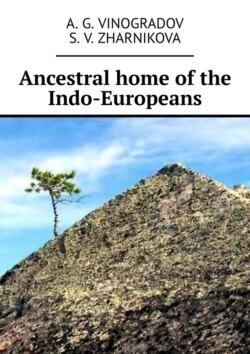Читать книгу Ancestral home of the Indo-Europeans - А. Г. Виноградов - Страница 4
Chapter 2 «Indo-European language and Indo-Europeans»
ОглавлениеThe next fundamental work devoted to the ancestral home of the Indo-Europeans, the main provisions of which I would like to dwell on, is the work of T. V. Gamkrelidze and Vyach. V. Ivanov’s «Indo-European language and Indo-Europeans», where the idea of a common Indo-European ancestral homeland on the territory of the Armenian Highlands and the adjacent areas of Western Asia, from where part of the Indo-European tribes then advanced into the Black Sea-Caspian steppes, develops and is thoroughly argued.
Paying tribute to the very high level of this encyclopedic work, which collected and analyzed a huge number of linguistic, historical facts, data from archeology and other related sciences, I would like to note that a number of provisions postulated by T. V. Gamkrelidze and Vyach. Ivanov, causes very serious doubts. So V. A. Safronov notes that: «The linguistic facts cited by Gamkrelidze and Ivanov in favor of localizing the Indo-European ancestral homeland on the territory of the Armenian Highlands can also receive other explanations. The absence of ie hydronymy in this area can only indicate against localization in it Indo-European ancestral home. Environmental data presented in the parsed work even more contradict such localization.In the territory of the Armenian Highlands there are almost half the animals, trees and plants listed in the list of flora and s listed Gamkrelidze and Ivanov, reconstructed in Indo-European (aspen, hornbeam, yew, linden, heather, beaver, lynx, grouse, salmon, elephant, monkey, crab).»
It is on these environmental data cited in the work of T. V. Gamkrelidze and Vyach. Ivanov, I would like to dwell in more detail. The authors of the «Indo-European language and Indo-Europeans» in confirmation of their concept, indicate the oldest names of trees recorded in the ancient Indo-European parent language.
These are birch, oak, beech, hornbeam, ash, aspen, poplar, yew, willow, branches, spruce, pine, fir, alder, walnut, apple, cherry, and dogwood.
As for the Armenian Highlands, at present it is a combination of folded-block ridges and tectonic depressions, often occupied by lakes – closed saline (Van, Urmia), and less commonly – flowing fresh (Sevan). The semi-desert and even desert landscapes are characteristic of the deepest depressions.» Here there are dry feather-grass fescue steppes turning into herbaceous grasses,» in some places in the middle reaches (between 1000 m and 2300 m.) There are dry rare-standing forests of deciduous oaks, pine and juniper.»
In the Iranian highlands, in the mountains of Zagros (on the western slopes and in the wetter northern part, between 1000 m and 1800 m), park oak forests with elm and maple are common, and wild mulberries, poplar, wall oak, and figs are found in the valleys. Due to the fact that in the middle period 1 thousand BC hitherto defined by climatologists as the period of cooling and moistening with respect to the climatic optimum of the Holocene (4—3 thousand BC) and the previous time (7—5 thousand BC), there is no reason to assume in these southern territories there is a much more humid and colder climate of 7—3 thousand BC, the time in question in the work of T. V. Gamkrelidze and V. V. Ivanov.
It should be noted that the significant fact is that in the common Indo-European vocabulary there are no names for many trees that are widespread in the Near East and Asia Minor from ancient times. These are:
olive (the primary focus of shaping in Asia Minor);
apricot (which was grown in 4 thousand BC even by residents of Tripoli settlements);
edible chestnuts, known in these territories from the Tertiary period;
quinces, which grows wild in northern Iran, Asia Minor and the Caucasus, where the primary centers of morphogenesis and introduction to culture were located;
loquat, in the wild distributed in the Caucasus, the Crimea and the North. Iran (the primary focus of shaping and introducing into the culture of Asia Minor);
almonds (the primary focus of forming Asia and the surrounding areas);
figs or figs, fig trees, found wild in the Near East, Asia Minor and the Mediterranean; and, finally, a date, the primary focus of domestication of which is Southern Iran and Afghanistan, where this plant was introduced into the culture in 5—3 thousand BC.
Olive
Blooming apricot
Apricot
Almond
Figs
Date fruit
Mushmula
Quince
This list can be greatly expanded. But even in such a fragmented form, he confirms that neither Front, nor Asia Minor, nor the Armenian Highlands could be the oldest ancestral home of the Indo-Europeans. And here again I would like to refer to the conclusion of P. Friedrich that: «the Pre-Slavic best of all other groups of Indo-European languages retained the Indo-European system of tree designation», and «the speakers of the common Slavic language lived in the ecological Slavic period (in particular, defined by wood flora), similar or identical to the corresponding zone of the common Indo-European, and after the general Slavic period, the carriers of various Slavic dialects continued to a significant extent to live in a similar area.»
